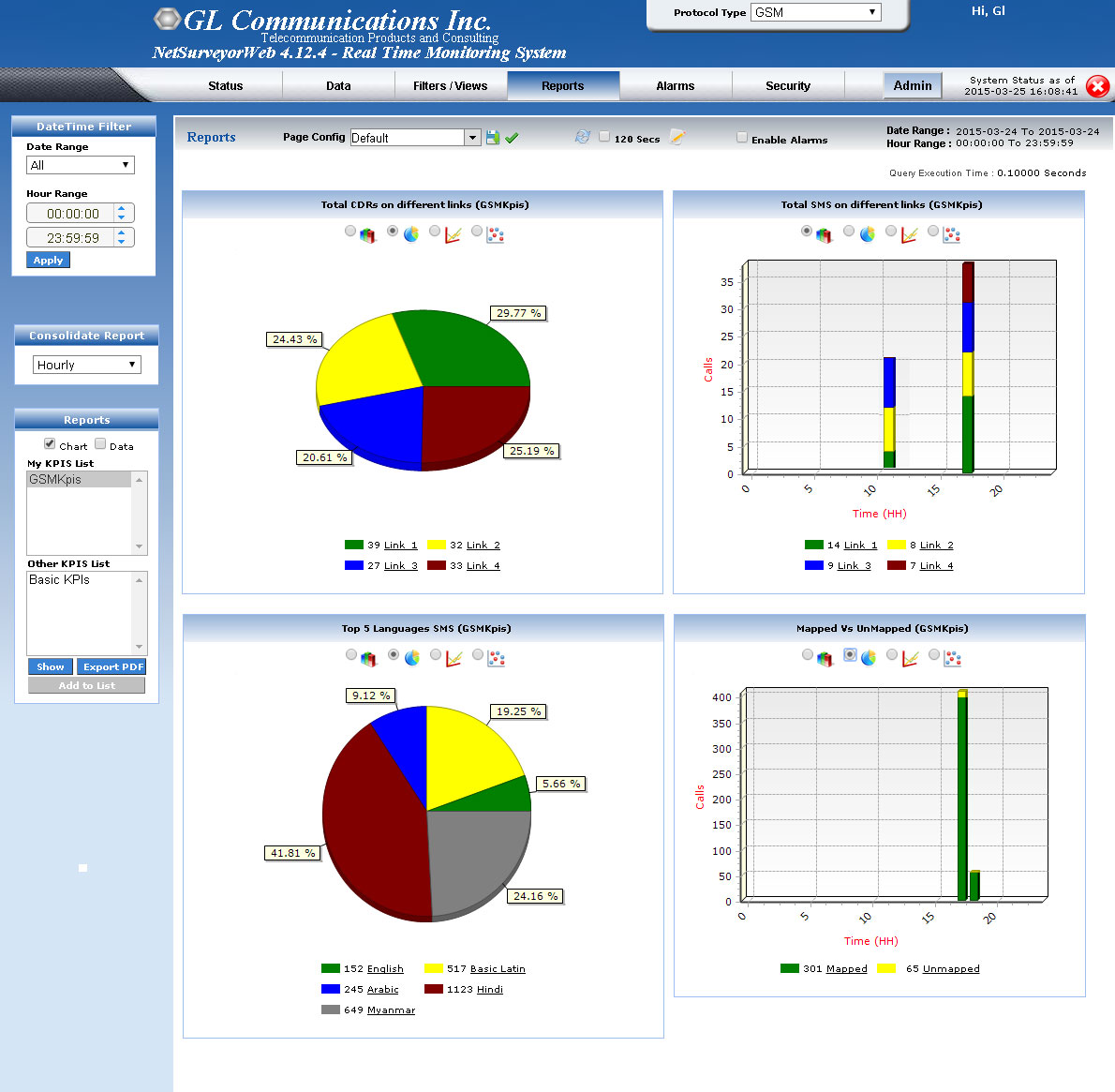GL Announces GSM Network Surveillance Software
Welcome to another March 2015 issue of GL's Newsletter providing information and insight into our latest GSM Network Surveillance software - for identifying, segregating, and analyzing different types of GSM Mobile calls over TDM and IP transport networks.

Centralized Web-based GSM Monitoring System
Overview
GL provides a variety of solutions for network wide monitoring and surveillance. The solution consist of: Intrusive and non-intrusive 'PC Probes' for TDM, VoIP, and Wireless Networks. Probes deployed at strategic locations in a network transmit and collect voice, data, protocol, statistics, and performance information, and relay this information to a central / distributed Network Management System (NMS) - called NetSurveyorWeb™. The NMS is WEB based system and consisting a database, and web applications for controlling, collecting, and analyzing the information provided by the various probes.
GL’s network monitoring and diagnostic system can be used for billing verification, remote protocol analysis, and traffic engineering. It can also provide key performance indicators, failure analysis, and call trace capability. A service provider or an equipment manufacturer must have the means to perform the aforementioned surveillance tasks cost effectively, remotely, automatically, and non-intrusively. Fortunately, the network backbone contains a wealth of information that can be monitored and collected to support these activities.
Functional Procedure
The GSM probes and TRAU probes over TDM networks captures GSM signaling as well as TRAU traffic data for calls being monitored, and transfers to Central Database System. The GSM IP probe - PacketScan™ captures GSM signaling as well as RTP traffic data over IP networks and transfers to Central Database System. The captured data will be made available to the customer in a sequential manner by NetSurveyorWeb™ GSM system. The features in NetSurveyorWeb™ GSMslightly varies for TDM and IP networks. The below table summarizes the available features -
| GSM over TDM | GSM over IP |
|---|---|
| GSM A, and Abis Interfaces | GSM A, and Abis Interfaces |
| TRAU Traffic Capture | RTP Traffic Capture |
| Signaling and Traffic from different probes and correlated using Mapping feature | Signaling and Traffic from the same probe not requiring Mapping procedure |
| Not Supported | Quality Scores (MOS, R-Factor) Supported |
| SMS Supported | SMS Supported |
| Reports and KPIs Supported | Reports and KPIs Supported |
User can customize the collected data and view the same for different purposes like troubleshooting, finding calls of interest, monitoring traffic, quality of service and more. And typical applications include Fraud Detection and Location, Remote Protocol Analysis and Troubleshooting, Real-time Signaling Monitor, Traffic Optimization Engineering, and Statistics.
User can determine actual call signaling routes to verify network functionality under all situations including congestion and loss of links. Also, the application provides the capability of alarm monitoring, non-intrusive testing of the T1 E1 alarms, and statistics.
Important Features
Call Detail Records (CDR)The CDR view in NetSurveyorWeb™ GSM system displays GSM call specific information such as Probe Name, Call Status, Calling Number, Called Number, Handover Information, SM Data, Traffic Related Information and so on. Email alerts can be setup to customize alarm conditions based on the CDR, and generate alerts. Other alert types such as visual alert, audible alert or even log are also supported. A CDR sample screen is shown.
GSM Call Types
The NetSurveyorWeb™ GSM system also identifies, segregates, and displays different GSM call types like Mobile Originated Call, Mobile Terminated Call, Mobile Originated SMS, Mobile Terminated SMS, Location Update, Incoming Handover, and Supplementary Services etc.
Mapping
The Mapping feature in NetSurveyorWeb™ GSM co-relates individually captured GSM signaling in GSM probes to proper voice channels captured in TRAU probes at the Abis Interface for each Mobile Call i.e GSM calls like Mobile Originating Call, Mobile Terminating Call and Handovers captured in GSM probes which includes signaling information. The CDR details of the call such as Start Time, Duration, Calling No, Called No etc are attached to captured Voice files so that user gets complete view of ‘Mobile Calls’ including voice.
Short Message Service (SMS)
The NetSurveyorWeb™ GSM system supports collection, decoding and storage of SMS data in plain textual formal in mass interception mode. User can tabulate and index the SMS user data into the CDR format. User can also perform the search/find operation based on some text/wild card characters over the SMS stored traffic.
Multi language Decoding of SMS - The system also has the provision to view SMS in all languages. The sample screen shown.
Voice Playback
The TRAU traffic captured on GSM Abis interface, is stored, and decoded into "glw" format. The captured signaling and TRAU traffic files are correlated, mapped, and combined voice call with CDR is to be made available to the net surveyor clients once the call is completed in the network. Using "voice playback" utility user can extract and play the voice pertaining to respective CDR. The sample screen is shown.
Multiple Filtering Options
User can choose any field from the Call Detail Records, apply logical conditions between fields, and between multiple filters to drill down to the specific "Calls of Interest" from hundreds to thousands of captured calls. Eg. Define the called/calling parties meeting certain QoS parameters.
Extensive Reports
The user has been provided with various report options such as SMS counters with respect to different languages, Mapped Vs Unmapped calls, Location Update Success Rate, Total CDRs , Total SMS, and Call Type Counters on various links etc. Flexible Report Generation feature allows user to export "custom reports views" in PDF or CSV file formats. The sample reports is shown.




 Back to Newsletter Index Page
Back to Newsletter Index Page